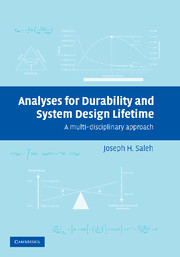Book contents
- Frontmatter
- Contents
- Preface
- 1 Introduction: On Time
- 2 To Reduce or to Extend Durability? A Qualitative Discussion of Issues at Stake
- 3 A Brief History of Economic Thought on Durability
- 4 Analysis of Marginal Cost of Durability and System Cost per Day
- 5 Flawed Metrics: System Cost per Day and Cost per Payload
- 6 Durability Choice and Optimal Design Lifetime for Complex Engineering Systems
- EPILOGUE: Perspectives in Design: The Deacon's Masterpiece and Hundred-Year Aircraft, Spacecraft, and Other Complex Engineering Systems
- APPENDIX A Beyond Cost Models, System Utility or Revenue Models: Example of a Communications Satellite
- APPENDIX B On Durability and Economic Depreciation
- Index
- References
2 - To Reduce or to Extend Durability? A Qualitative Discussion of Issues at Stake
Published online by Cambridge University Press: 25 October 2009
- Frontmatter
- Contents
- Preface
- 1 Introduction: On Time
- 2 To Reduce or to Extend Durability? A Qualitative Discussion of Issues at Stake
- 3 A Brief History of Economic Thought on Durability
- 4 Analysis of Marginal Cost of Durability and System Cost per Day
- 5 Flawed Metrics: System Cost per Day and Cost per Payload
- 6 Durability Choice and Optimal Design Lifetime for Complex Engineering Systems
- EPILOGUE: Perspectives in Design: The Deacon's Masterpiece and Hundred-Year Aircraft, Spacecraft, and Other Complex Engineering Systems
- APPENDIX A Beyond Cost Models, System Utility or Revenue Models: Example of a Communications Satellite
- APPENDIX B On Durability and Economic Depreciation
- Index
- References
Summary
PREVIEW AND GUIDE TO THE CHAPTER
As we discussed in the first chapter, the implications for selecting a reduced or extended product durability are complex and multidisciplinary in nature. They affect an entire industry value chain and should not be reduced solely to the revenues or profits for the manufacturers resulting from the sales of the goods (as is often done in the economic literature on the subject). There are tangible and intangible consequences from the decision to reduce or extend a product's durability or a system's design lifetime. This chapter discusses the qualitative implications associated with the choice of reducing or extending a product's durability or a system design lifetime, as seen from the perspective of three stakeholders, the customer, the manufacturer, and society at large.
Introduction
As discussed in the first chapter, there is a popular belief that probably dates back to the 1930s that manufacturers of durable goods often deliberately reduced the durability of their products in order to increase their sales and profits. There is some historical evidence that gives credence to such a belief in the particular cases of the electric light bulb, razor blade, and vacuum tube industries. However, it is generally agreed that consumers would have been better served by longer-lived products.
Consider, for example, the electric light bulb industry. This industry was highly cartelized in the first half of the 20th-century, and its cartel often took proactive measures to limit lamp life or the durability of the bulb, with the obvious objective of increasing sales for the cartel members.
- Type
- Chapter
- Information
- Analyses for Durability and System Design LifetimeA Multidisciplinary Approach, pp. 14 - 23Publisher: Cambridge University PressPrint publication year: 2007



